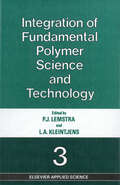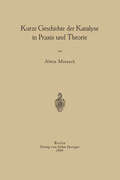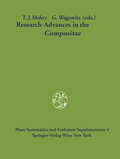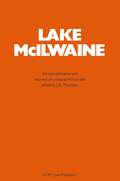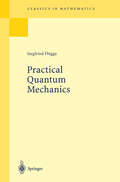- Table View
- List View
Essential Building Blocks of Human Nature (The Frontiers Collection)
by Ulrich J. Frey Charlotte Störmer Kai P. WillführTo understand why we humans are as we are, it is necessary to look at the essential building blocks that comprise our nature. The foundations of this structure are our evolutionary origins as primates and our social roots. Upon these rest features such as our emotions, language and aesthetic preferences, with our self-perceptions, self-deceptions and thirst for knowledge right at the top.The unifying force holding these blocks together is evolutionary theory. Evolution provides a deeper understanding of human nature and, in particular, of the common roots of these different perspectives.To build a reliable and coherent model of man, leading authors from fields as diverse as primatology, anthropology, neurobiology and philosophy have joined forces to present essays each describing their own expert perspective. Together they provide a convincing and complete picture of our own human nature.
Lehrbuch der Entwicklungsgeschichte des Menschen
by H. K. CorningDieser Buchtitel ist Teil des Digitalisierungsprojekts Springer Book Archives mit Publikationen, die seit den Anfängen des Verlags von 1842 erschienen sind. Der Verlag stellt mit diesem Archiv Quellen für die historische wie auch die disziplingeschichtliche Forschung zur Verfügung, die jeweils im historischen Kontext betrachtet werden müssen. Dieser Titel erschien in der Zeit vor 1945 und wird daher in seiner zeittypischen politisch-ideologischen Ausrichtung vom Verlag nicht beworben.
Cloud Systems, Hurricanes, and the Tropical Rainfall Measuring Mission: A Tribute to Joanne Simpson (Meteorological Monographs)
by Wei-Kuo TaoThis book is a tribute to a pioneer in tropical meteorology research, Dr. Joanne Simpson. It is a recollection of some of the high points of her career, from her fifty years of investigating hurricanes and clouds to her management of the crutial and highly successful TRMM project (Tropical Rainfall Measuring Mission), a joint mission between the NASA and the Japan Aerospace Exploration Agency (JAXA).
Galactic and Extragalactic Star Formation (Nato Science Series C: #232)
by Ralph E. Pudritz Michel FichRecent advances in the instrumentation used to observe star forming regions in both our own Milky Way and in external galaxies have transformed the subject from a phenomenological pursuit into an increasingly unified, physical science. High resolution centimetre, millimetre, infrared, and optical studies of local star forming clouds have allowed us to probe the physics of star formation down to spatial scales approaching those of the solar system. These developments make it possible to better constrain the basic physical processes underlying star formation itself. At the same time, these new instruments have placed extragalactic studies on a footing detailed enough to allow comparison with star forming regions within our own galaxy. This revolution means that we will soon be able to link the physics of local star forming regions to the global star forming properties of galaxies. The entire structure of this NATO Advanced Study Institute was designed to explore this new view of the subject. This Institute on "Galactic and Extragalactic Star Formation" was held from June 21 -July 4, 1987 at the Conference Centre in the village of Whistler, British Columbia, Canada. The informal atmosphere of this lovely mountain resort stim ulated many valuable scientific exchanges. The Institute was funded by a major grant from NATO Scientific Affairs. Additional financial and I.I1oral assistance was provided by the Canadian Institute for Theoretical Astrophysics (CITA) and Mc Master University.
Integration of Fundamental Polymer Science and Technology—3
by P. J. Lemstra L. A. KleintjensThe Rolduc Polymer Meetings, of which the contents of this volume represent the third, are already on their way to occupying a unique place in the crowded calendar of symposia on every aspect of polymer science and engineering. They combine manageable meeting size with a theme, 'Integration of Fundamental Polymer Science and Technology', which is often discussed but seldom realized in practice. The technological, or applied, areas of polymers have perhaps received more emphasis historically than those of other allied disciplines. Indeed, various plastic and rubber materials were successful items of commerce long before the macromolecular concept itself was firmly established. The more fundamental aspects of the field were also largely developed in industrial laboratories. The early work of Mark and Meyer at IG Farben, and that of Carrothers and Flory at Du Pont, are good examples of this. The present situation, in which polymers are being applied to more and more demanding end uses, from high performance materials on the one hand to the biomedical and electronics fields on the other, caIls for an ever greater understanding of the basic scientific principles governing their behavior. It is evident, therefore, that interactions between those engaged in the 'pure' and 'applied' parts of the field must be promoted effectively. The Rolduc Polymer Meetings contribute significantly to such interactions, not only by interweaving technological and scientific presentations, but also by providing a forum for the participants to discuss problems of mutual interest in all their complexity.
Dissipative Systems Analysis and Control: Theory and Applications (Communications and Control Engineering)
by Bernard Brogliato Rogelio Lozano Bernhard Maschke Olav EgelandThis second edition of Dissipative Systems Analysis and Control has been substantially reorganized to accommodate new material and enhance its pedagogical features. It examines linear and nonlinear systems with examples of both in each chapter. Also included are some infinite-dimensional and nonsmooth examples. Throughout, emphasis is placed on the use of the dissipative properties of a system for the design of stable feedback control laws.
Geomechanics of Failures. Advanced Topics
by Eduardo E. Alonso Núria M. Pinyol Alexander M. PuzrinGeotechnical failures, specially the catastrophic ones, are a stimulus to improve current understanding of phenomena and procedures and tools for analysis and prediction. This unconventional approach to geomechanics is the essence of this book. In general, soil mechanics and geotechnical textbooks describe first the concepts and theoretical developments and then apply them to interpret or solve a particular applications. This book follows a different course. The case (a failure) is first described and then an explanation is sought. This requires a set of steps which can be summarized as follows: Identify the nature of the problem, develop a dedicated and specific formulation of the case, based on established basic concepts. In general, no single existing theory or procedure is available to solve the case at hand, provide a solution within an acceptable degree of complexity, extract the fundamental aspects of the problem and highlight its relevance. The cases selected have been grouped into three main topics: Landslides, Embankments and Dams and Dynamics of Failures. Cases selected (Vaiont, Aznalcóllar, Brattas-St. Moritz) are unique and illustrate a number of relevant and to some extent controversial issues which are of wide interest, without claiming exhaustive treatment of the subject. The book teaches how to build the necessary models to understand the failures. Well established soil mechanics concepts are the necessary background. But the cases analyzed require in general a step ahead which is specific for the case analyzed. Balance and equilibrium equations are often required as a starting point. They are formulated at different scales, which are selected having in mind the abstract representation of each case. Various chapters illustrate also the coupled nature (flow-deformation-temperature) of geotechnical problems and the need to properly address these complexities in some cases. In fact, temperature effects, a subject often neglected in conventional analyses, are necessary to explain some catastrophic landslides (Vaiont). In some of the chapters, specific calculation tools, included in well known and widely available programs (Excel, Maple…) have been used. Details of the ad hoc programs developed have also been included in Appendices to help the readers to follow the details of the calculation. Finite element methods have not been used. In the landslides analyzed (Vaiont and Brattas-St. Moritz) currently available commercial programs are of limited utility. In the remaining cases the analysis performed provides a sufficient insight and interpretation of field behaviour. Chapters include also a short description of the changes in the original design and the mitigation measures which could have prevented the failure. Also, a summary section of lessons learned is provided in all chapters. Finally, selected topics and more advanced reading are suggested. This book is associated with a Master/Doctorate course being offered at the Department of Geotechnical Engineering and Geosciences of UPC, Barcelona. Potential readers therefore include Graduate and Master students, faculty and professionals in the fields of Civil and Geotechnical Engineering.
Trees and Hierarchical Structures: Proceedings of a Conference held at Bielefeld, FRG, Oct. 5–9th, 1987 (Lecture Notes in Biomathematics #84)
by Andreas Dress Arndt Van HaeselerThe "raison d'etre" of hierarchical dustering theory stems from one basic phe nomenon: This is the notorious non-transitivity of similarity relations. In spite of the fact that very often two objects may be quite similar to a third without being that similar to each other, one still wants to dassify objects according to their similarity. This should be achieved by grouping them into a hierarchy of non-overlapping dusters such that any two objects in ~ne duster appear to be more related to each other than they are to objects outside this duster. In everyday life, as well as in essentially every field of scientific investigation, there is an urge to reduce complexity by recognizing and establishing reasonable das sification schemes. Unfortunately, this is counterbalanced by the experience of seemingly unavoidable deadlocks caused by the existence of sequences of objects, each comparatively similar to the next, but the last rather different from the first.
Differentiation and Neoplasia (Results and Problems in Cell Differentiation #11)
by R. G. McKinnell M. A. Diberardino M. Blumenfeld R. D. BergadThere is no commonly accepted mechanism to explain differentiation of either normal or neoplastic cells. Despite this fact, the organizers of the 3 rd International Conference on Differentiation recognized that there is much emerging evidence which supports the view that both normal cells and many cancer cells share common differentiative processes. Accordingly, the organizers perceived that clinical scientists and developmental biologists would greatly benefit by together considering differentiation. In that way, developmental biologists would be apprised of recent insights in cancer cell biology and the physician scientist would be updated on events in developmental biology and both would gain new understanding of the cell biology of neoplasia. A specific example may reveal the potential value of developmental biologists interacting with cancer physicians. An example chosen at random suggests that probably any paper included in the symposium volume would serve the purpose. Dr. Stephen Subtelny reviewed recent studies by his laboratory concerning germ cell migration and replication in frog embryos. How might those results interest the cancer scientist? Dr. Subtelny showed that primordial germ cells of a fertile graft will reverse their migratory direction and move into a sterile host. Perhaps in this context it would not be inappropriate to state that the germ cells of the graft metastasized into the host. Germ cells from grafts of a different species will populate the previously sterile host gonad.
Growth and Defence in Plants: Resource Allocation at Multiple Scales (Ecological Studies #220)
by Rainer Matyssek, Hans Schnyder, Wolfgang Oßwald, Dieter Ernst, Jean Charles Munch and Hans PretzschPlants use resources, i.e. carbon, nutrients, water and energy, either for growth or to defend themselves from biotic and abiotic stresses. This volume provides a timely understanding of resource allocation and its regulation in plants, linking the molecular with biochemical and physiological-level processes. Ecological scenarios covered include competitors, pathogens, herbivores, mycorrhizae, soil microorganisms, carbon dioxide/ozone regimes, nitrogen and light availabilities. The validity of the “Growth-Differentiation Balance Hypothesis” is examined and novel theoretical concepts and approaches to modelling plant resource allocation are discussed. The results presented can be applied in plant breeding and engineering, as well as in resource-efficient stand management in agriculture and forestry.
Kurze Geschichte der Katalyse in Praxis und Theorie
by NA MittaschDieser Buchtitel ist Teil des Digitalisierungsprojekts Springer Book Archives mit Publikationen, die seit den Anfängen des Verlags von 1842 erschienen sind. Der Verlag stellt mit diesem Archiv Quellen für die historische wie auch die disziplingeschichtliche Forschung zur Verfügung, die jeweils im historischen Kontext betrachtet werden müssen. Dieser Titel erschien in der Zeit vor 1945 und wird daher in seiner zeittypischen politisch-ideologischen Ausrichtung vom Verlag nicht beworben.
Ergebnisse der Biologie: Dreizehnter Band
by K.v. Frisch R. Goldschmidt W. Ruhland H. WintersteinDieser Buchtitel ist Teil des Digitalisierungsprojekts Springer Book Archives mit Publikationen, die seit den Anfängen des Verlags von 1842 erschienen sind. Der Verlag stellt mit diesem Archiv Quellen für die historische wie auch die disziplingeschichtliche Forschung zur Verfügung, die jeweils im historischen Kontext betrachtet werden müssen. Dieser Titel erschien in der Zeit vor 1945 und wird daher in seiner zeittypischen politisch-ideologischen Ausrichtung vom Verlag nicht beworben.
Research Advances in the Compositae (Plant Systematics and Evolution - Supplementa #4)
by T. J. Mabry Gerhard WagenitzT. J. MABRY and G. W AGENITZ The half-day symposium on "Multidisciplinary approaches to the systematics of Compositae", held as part of the XIV International Botanical Congress in Berlin, on July 26, 1987, was designed to complement the University of Reading Compositae Conference (1975). The latter had yielded two impressive and thorough volumes on "The biology and chemistry of the Compositae", which were edited by HEYWOOD, HARBORNE & TURNER (1977). The 1987 Berlin Symposium did not attempt to update the information from the earlier conference but instead focussed on selected new methods for investigating the systematics of the family as well as a few examples of new systematic approaches with classical methods. From mapping chloroplast DNA restriction sites JANSEN, PALMER, and MI CHAELS reported the astonishing fact that, with the exception of one group (the subtribe Barnadesiinae of the tribe Mutisieae), all investigated other members of Compositae exhibit a characteristic inversion in their chloroplast DNA, suggesting that the inversion occurred early in the evolution of the family and that at least its major part is monophyletic. Within those groups with the inverted segment, chloroplast DNA also suggests that most of the conventionally recognized tribes are also monophyletic. This lends high credit to our predecessors who laid the foundations for the taxonomic system of the Compositae. These chloroplast DNA studies have already been published and are not included here (JANSEN & PALMER 1987, 1988).
Microbial Diversity in Ecosystem Sustainability and Biotechnological Applications: Volume 2. Soil & Agroecosystems
by Tulasi Satyanarayana Subrata Kumar Das Bhavdish Narain JohriThis volume comprehensively reviews recent advances in our understanding of the diversity of microbes in various types of terrestrial ecosystems, such as caves, deserts and cultivated fields. It is written by leading experts, and highlights the culturable microbes identified using conventional approaches, as well as non-culturable ones unveiled with metagenomic and microbiomic approaches. It discusses the role of microbes in ecosystem sustainability and their potential biotechnological applications. The book further discusses the diversity and utility of ectomycorrhizal and entomopathogenic fungi and yeasts that dwell on grapes, it examines the biotechnological applications of specific microbes such as lichens, xylan- and cellulose-saccharifying bacteria and archaea, chitinolytic bacteria, methanogenic archaea and pathogenic yeasts.
Food, Science and Society: Exploring the Gap Between Expert Advice and Individual Behaviour (Gesunde Ernährung Healthy Nutrition)
by P. S. Belton T. Belton T. Beta D. Burke L. Frewer A. Murcott J. Reilly G. M. SeddonThere is widespread concern amongst consumers about the safety and acceptability of food, and there are clearly communication gaps between consumers, many food professionals and food industry. This book offers accounts of the two-way nature of this difficult communication process and steps that can be made to bridge these communication gaps in a variety of social and cultural environments. Individual chapters of the book analyze the roles of science, culture, and risk perception, and of mass media and attitudes towards eating. An additional section describes the interface between scientists and lay people with regard to policy-making and agricultural practice.
Lake Mcilwaine: The Eutrophication and Recovery of a Tropical African Man-Made Lake (Monographiae Biologicae #49)
by J. A. Thornton'And God said, Let there be a firmament in the midst of the waters, and let it divide the waters from the waters. ' Genesis 1:6 Lake McIlwaine is a man-made lake. It was formed in 1952 by the Hunyani poort Dam and is situated on the Hunyani River some 37 km southwest of Salisbury* in the Republic of Zimbabwe**. It is a lake of many aspects: being a popular recreational site, the City's primary water supply reservoir (and the fourth largest impoundment in Zimbabwe), a source of irrigation water to downstream farms, an important fishery, and, until the 1970s, the receptacle of Salisbury's sewage effluent. It is, in short, typical of so many 'urban' lakes in Africa and throughout the world. Lake McIlwaine is also unique, to my knowledge: being amongst the first of the major man-made lakes on the continent to suffer from what is known as cultural eutrophication, and the first to be r:ehabilitated to a mesotrophic state through a rational programme of lake management. This volume synthesizes this process of eutrophication and recovery in terms of the geology and geography (Chapter 2), physics (Chapter 3), chemistry (Chapter 4) and biology (Chapter 5) of the lake, and, whilst discussion of the trophic relationships between these components is beyond the scope of this monograph, discusses its utilisation, conservation and management (Chapter 6). * Subsequent to writing, the name of the Zimbabwean capital was changed to Harare on 18 April 1982. - Ed.
Udder Health and Communication
by H. Hogeveen and T. J. G. M. LamIn dairy industries throughout the world there is a desire to optimize udder health. An improved udder health will lead to improved animal welfare, improved production efficiency and a reduction of the use of antibiotics. To improve udder health, first of all, technical knowledge on issues such as treatment, milking, infectious pressure and host resistance is important. However, over the years we learned that knowledge alone is not enough: knowledge has to be used. And for knowledge to be used, farmers have to be motivated. This requires knowledge about motivation and communication. In this book, recent knowledge on technical udder health issues is combined with knowledge on motivation and communication. A large number of descriptions of mastitis control programs that are being carried out worldwide is combined with more specific studies. These are aimed at effective advising, motivation and communication strategies, economics, and technical studies on mastitis control and prevention. Therefore, this book provides an applied source of information for all that are willing to improve udder health.
Die Physikalischen und Technischen Grundlagen der Hochfrequenzbehandlung: Diathermie · Arsonvalisation · Kurzwellen
by Hans Weisz J. KowarschikDieser Buchtitel ist Teil des Digitalisierungsprojekts Springer Book Archives mit Publikationen, die seit den Anfängen des Verlags von 1842 erschienen sind. Der Verlag stellt mit diesem Archiv Quellen für die historische wie auch die disziplingeschichtliche Forschung zur Verfügung, die jeweils im historischen Kontext betrachtet werden müssen. Dieser Titel erschien in der Zeit vor 1945 und wird daher in seiner zeittypischen politisch-ideologischen Ausrichtung vom Verlag nicht beworben.
Internal Logic: Foundations of Mathematics from Kronecker to Hilbert (Synthese Library #310)
by Y. GauthierInternal logic is the logic of content. The content is here arithmetic and the emphasis is on a constructive logic of arithmetic (arithmetical logic). Kronecker's general arithmetic of forms (polynomials) together with Fermat's infinite descent is put to use in an internal consistency proof. The view is developed in the context of a radical arithmetization of mathematics and logic and covers the many-faceted heritage of Kronecker's work, which includes not only Hilbert, but also Frege, Cantor, Dedekind, Husserl and Brouwer. The book will be of primary interest to logicians, philosophers and mathematicians interested in the foundations of mathematics and the philosophical implications of constructivist mathematics. It may also be of interest to historians, since it covers a fifty-year period, from 1880 to 1930, which has been crucial in the foundational debates and their repercussions on the contemporary scene.
Practical Quantum Mechanics (Classics in Mathematics)
by Siegfried FlüggeThis work was first published in 1947 in German under the title "Re chenmethoden der Quantentheorie". It was meant to serve a double purpose: to help both, the student when first confronted with quantum mechanics and the experimental scientist, who has never before used it as a tool, to learn how to apply the general theory to practical problems of atomic physics. Since that early date, many excellent books have been written introducing into the general framework of the theory and thus indispensable to a deeper understanding. It seems, however, that the more practical side has been somewhat neglected, except, of course, for the flood of special monographs going into broad detail on rather restricted topics. In other words, an all-round introduction to the practical use of quantum mechanics seems, so far, not to exist and may still be helpful. It was in the hope of filling this gap that the author has fallen in with the publishers' wish to bring the earlier German editions up to date and to make the work more useful to the worldwide community of science students and scientists by writing the new edition in English. From the beginning there could be no doubt that the work had to be much enlarged. New approximation methods and other developments, especially in the field of scattering, had to be added. It seemed necessary to include relativistic quantum mechanics and to offer, at least, a glimpse of radiation theory as an example of wave field quantization.
Mechanics and Physics of Energy Density: Characterization of material/structure behaviour with and without damage (Engineering Applications of Fracture Mechanics #9)
by George C Sih E. E. GdoutosMaterial technology has become so diversified in theories and the construction of novel microstructures that the researchers and practitioners are drifting further apart. This book is based on material presented at an International Symposium in Xanthi, Greece in July 1989. The symposium attracted a group of individual engineers and scientists from the East and West who tackled the question of why particular manipulations of a given material have particular effects. Emphasis is laid on the strain energy function because of the versatile role it plays in mechanics and physics. It has been used successfully not only in predicting the failure of solids but also in formulating constitutive relations in continuum mechanics. The material presented falls within the areas of: Fundamentals of Strain Energy Density, Damage Analysis on Strain Energy Density, Strain Energy Density as Failure Criterion, Applications, and Composites.
Umwelt-Bioverfahrenstechnik
by Peter KunzIn zunehmendem Maße werden in der industriellen Produktion und in der Entsorgung umweltverträgliche Techniken, die häufig auf dem Einsatz von Mikroorganismen beruhen, eingesetzt. Dieses Lehrbuch führt in die Grundlagen und Anwendungen der biologischen Technik ein, stellt ihre Möglichkeiten und Grenzen vor und zeigt neue Lösungs- und Entwicklungsansätze der Bioverfahrenstechnik aus dem Blickwinkel der Umweltvorsorge auf. Das Buch ist aus Vorlesungen und Kursen entstanden, die der Autor in verschiedenen Institutionen gehalten hat.
Aging of the Organs and Systems (Biology of Aging and its Modulation #3)
by Richard AspinallDuring the last 40 years, the study of the biological basis of aging has progressed tremendously, and it has now become an independent and respectable field of study and research. This volume on "Aging of Organs and Systems", is an attempt to bring understanding to both the aging process and the disease processes of old age. Bringing together contributions from an international team of authors, it will be of interest to graduates and postgraduates in the fields of medicine and nursing, researchers of different aspects of biogerontology and those in the pharmaceutical, cosmeceutical, nutriceutical and health-care industry.
Saline Lakes: Proceedings of the Fourth International Symposium on Athalassic (inland) Saline Lakes, held at Banyoles, Spain, May 1988 (Developments in Hydrobiology #59)
by F. A. Comin T. G. NorthcoteProceedings of the IV International Symposium on Athalassic (Inland) Saline Lakes
Population Genetics (Monographs on Statistics and Applied Probability)
by W.J. EwensPopulation genetics is the mathematical investigation of the changes in the genetic structure of populations brought about by selection, mutation, inbreeding, migration, and other phenomena, together with those random changes deriving from chance events. These changes are the basic components of evolutionary progress, and an understanding of their effect is therefore necessary for an informed discussion of the reasons for and nature of evolution. It would, however, be wrong to pretend that a mathematical theory, depending as it must on a large number of simplifying assump tions, should be accepted unreservedly and that its conclusions should be accepted uncritically. No-one would pretend that in the event of disagreement between observation and mathematical prediction, the discrepancy is due to anything other than the inadequacy of the mathematical treatment. The biological world is, of course, far too complex for the study of population genetics to be simply a branch of applied mathematics, so that while we are concerned here with the mathematical theory, I have tried to indicate which of our results should continue to apply in a context wider than that in which they are formally derived. The difficulties involved in the joint discussions of mathematical and genetical problems are obvious enough. I have tried to aim this book rather more at the mathematician than at the geneticist, and for this reason a brief glossary of common genetical terms is included.




